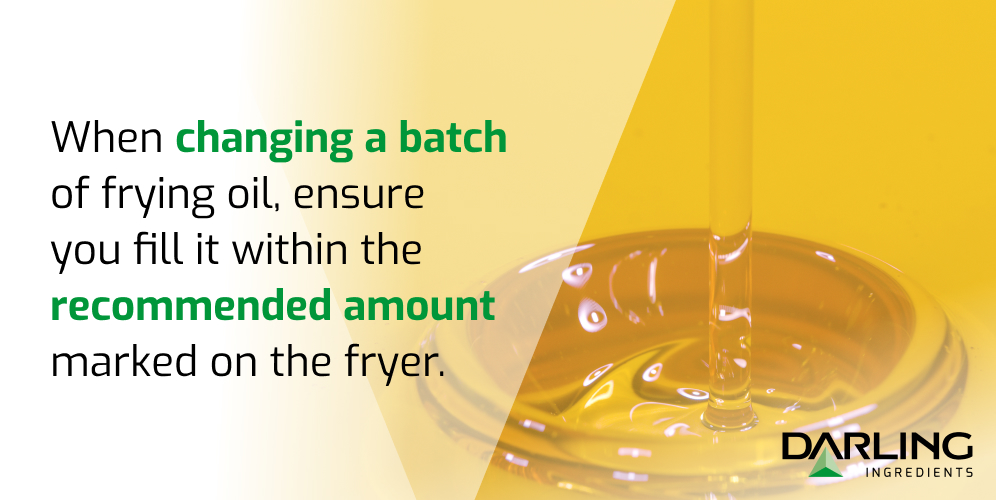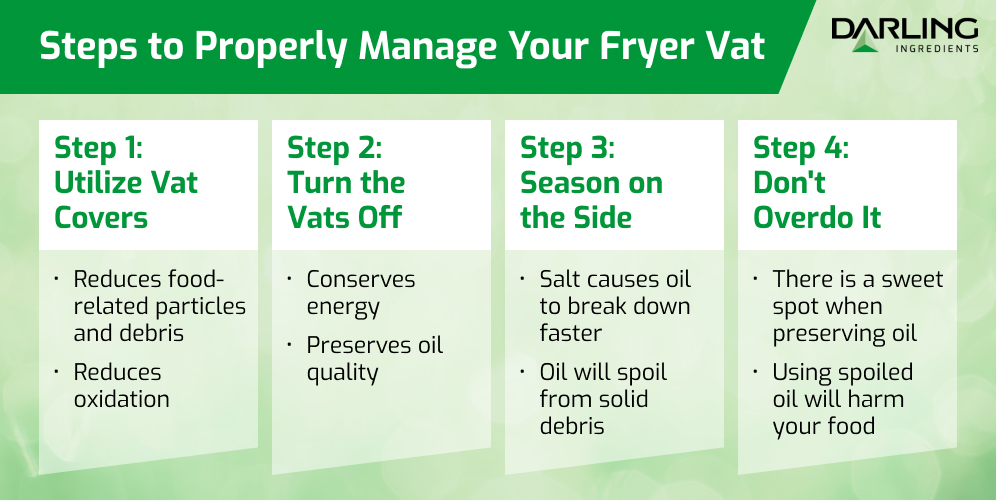These numbers have quickly dented the bottom line of many restaurants, especially those with large amounts of fried foods. Due to food-related costs, many kitchens have attempted to extend their oil beyond its frying life—adversely affecting the taste of their menu items.
The situation has left restaurant kitchens in quite a predicament. Do they continue to sacrifice the taste and quality of their food items? Or should they continue to change their fryer oil frequently while bearing the cost of premium-price oil?
We're here to help because we understand nobody wants soggy, poor-tasting mozzarella sticks and fries. We also recognize that over-frequent oil changes waste company dollars. Thankfully, according to the USDA prices of food are expected to increase at slower rates in 2023 than prior years, but are still high. That’s why we’ve prepared some simple steps to extend the life of your oil without negatively affecting the taste and quality of your food.

What Causes Restaurant Oil to Break Down?
It's essential to understand what makes oil go bad so that you can develop safe ways to extend its life. Some will be inevitable, but others are preventable.
Four things cause cooking oil to break down: air, heat, light, and moisture. When fried, food releases oxygen-containing water molecules. When oil comes in contact with water and oxygen, it oxidizes, breaking down faster. Oxidation is a natural byproduct of the frying process, but solid food particles can make cooking oil less than fresh.
Steps to Properly Handle Your Oil
Finding the correct type of cooking oil for your restaurant's needs is key to ensuring your food tastes delicious and you remain within budget. However, there are steps you should take to properly handle your oil, regardless of which type it is.
Step 1: Regular Filtration
Filtration rids your oil of solid food particles and other accidental debris. It's a necessary process that prolongs your oil's life and helps save costs. Some fryers have built-in filtration systems. If yours does not, manually utilize a strainer or portable filtration machine, which will also help you to safety transfer oil to an automated tank when it is time to discard it.
Step 2: Avoid Overfilling
When changing a batch of frying oil, ensure you fill it within the recommended amount marked on the fryer. Overfilling a fryer increases the risk of an overflow or spill. It also means that the batch will take longer to reach its appropriate frying temperature.

Step 3: Regularly Skim
Train your staff to skim the sides and top of your fryer 1-2 times every hour. Skimming eliminates errant food particles, helping to keep your oil cleaner for longer.
Step 4: Smoke Point
"Smoke point" is the term used to describe the temperature at which oil breaks down. Cooking oils may have different smoke points, depending on their types. Oil will burn or go bad when it exceeds its smoke point temperature, which needlessly wastes batches. Knowing your oil's smoke point means you can be sure you stay within its temperature threshold.
Steps to Properly Manage Your Fryer Vat
The vat is where oil lives within the fryer. Proper management of the vat can prolong the life of your frying oil. Below are four steps for appropriate upkeep.
Step 1: Utilize Vat Covers
Covering the fryer vats between frying cycles limits the number of food-related particles and debris from the batch. It also reduces oxidation by reducing the oil's exposure to light and moisture.
Step 2: Turn the Vats Off
Make a habit of turning the vats off when not frying. A simple switch conserves energy and preserves oil quality because it isn't heated when not needed.
Step 3: Season on the Side
When you pull a fresh batch of chicken tenders out of the fryer basket, it's tempting to want to salt and season it right there. Resist the urge and season your dish on the side instead. Salt is oil's nemesis and causes it to break down faster. Plus, the more solid debris finds its way into the oil, the faster it will spoil.
Step 4: Don't Overdo It
Refrain from letting the high cost of cooking oil tempt you into stretching it too far. When it comes to preserving oil quality, there is a sweet spot. Your goal should be to extend that sweet spot, not use a batch for as long as possible. Once oil spoils, continuing to fry it will harm your food's taste, smell, and texture.
Here's a guide to help you identify when your oil is going bad.

What About FreshFry Pods?
If you're wondering what a FreshFry pod is, it's a tool that loosely resembles a dishwasher pod. The pod acts as a vacuum inside a batch of oil. The pod soaks in the oil, removing water and other debris, which keeps the batch fresher for longer.
FreshFry pods are proven to extend the life of used cooking oil drastically and are readily available for purchase. Remember, you should still regularly filter your oil, but these pods provide an additional filtering measure.
How Do FreshFry Pods Work?
Once you're finished frying for the day, drop a FreshFry pod into the oil while still hot. Oil hardens as it cools, which makes it harder for the pod to extract unwanted material if it's dropped in too late. Remove the pod and discard it when you return to work the next day.
The Rise of Cooking Oil Theft
Even after the initial purchase, restaurant frying oil remains valuable as professionals can repurpose used oil for biofuel. Because of its hidden value, some refer to used cooking oil as "liquid gold." The pseudonym sounds nice, but for many restaurants, the relationship equates to an increased prevalence of theft.
With the price of cooking oil on the rise, it's no surprise that grease theft is too. While it may seem like a ridiculous crime, it's an eight-figure black market. With thieves making as much as $1,500 per day off stolen oil, there is increased risk to restaurant employees and property damage.

Partnering with Darling Ingredients Canada
We expect the price of fryer oil will continue to rise in 2023. Being prepared with proactive measures will help cut costs and improve your bottom line.
Darling Ingredients Canada has led the industry in world-class used cooking oil containment and system design for over 30 years. Today, our storage tanks and containers push beyond industry expectations to meet the needs of our clients. We offer automated systems that attach directly to your existing fryer, quickly draining your used oil and making theft virtually nonexistent.
Let us help you get the most out of your fryer oil. Contact us today to learn about our used cooking oil recycling program and equipment. We look forward to hearing from you.
Contact Sales
For customer service inquiries call our toll free number (800) 263-0302
By submitting this form I agree to the privacy policy including the usage of contact details to contact me for marketing purposes.
